 |
 |
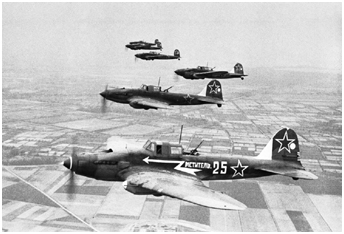
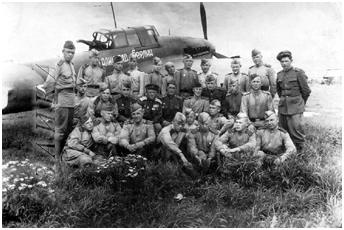 When World War II ended in Europe in May 1945, it was common knowledge that the main ground attack plane (shturmovik in Russian) of the VVS RKKA (1)
was the Ilyushin Il-2 on the way to become a legend as did its ground counterpart, the T-34. Although barely 70 of approximately 250 Il-2 single-seaters built were in service at the beginning of the Great Patriotic War,
the aircraft that Stalin once designated in a threatening telegram addressed to the directors of factories No.1 and No.18 as being as necessary to The Red Army as air and bread
(> Link), would end as the most manufactured aircraft during the war with more than 36,000 aircraft built, a figure unfortunately to be compared to the number
of losses, which also was very high. No wonder then that there were no less than 19 ground attack aviation regiments (Shturmovoy Aviatsionnyy Polk - ShAP) divided into 6 ground attack aviation divisions
(Shturmovaya Aviatsionnaya Diviziya - ShAD) themselves partly subordinate to 2 ground attack aviation corps (Shturmovoy Aviatsionnyy Korpus - ShAK) mainly equipped with Il-2 within the 16.VA
in the Soviet occupation zone at the end of the war in Germany.
When World War II ended in Europe in May 1945, it was common knowledge that the main ground attack plane (shturmovik in Russian) of the VVS RKKA (1)
was the Ilyushin Il-2 on the way to become a legend as did its ground counterpart, the T-34. Although barely 70 of approximately 250 Il-2 single-seaters built were in service at the beginning of the Great Patriotic War,
the aircraft that Stalin once designated in a threatening telegram addressed to the directors of factories No.1 and No.18 as being as necessary to The Red Army as air and bread
(> Link), would end as the most manufactured aircraft during the war with more than 36,000 aircraft built, a figure unfortunately to be compared to the number
of losses, which also was very high. No wonder then that there were no less than 19 ground attack aviation regiments (Shturmovoy Aviatsionnyy Polk - ShAP) divided into 6 ground attack aviation divisions
(Shturmovaya Aviatsionnaya Diviziya - ShAD) themselves partly subordinate to 2 ground attack aviation corps (Shturmovoy Aviatsionnyy Korpus - ShAK) mainly equipped with Il-2 within the 16.VA
in the Soviet occupation zone at the end of the war in Germany.
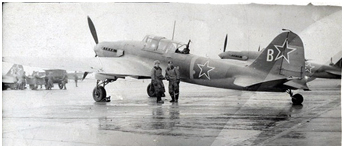
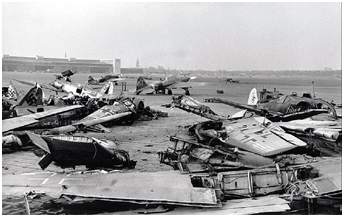 We must add to this for a brief period the aircraft of the 2.VA in the south (First Ukrainian Front) and those of the 4.VA in the north (Second Belarusian Front) that participated with the 16.VA in the center
(First Belarusian Front), to the final assault on the Reich. For the sake of completeness, we will also mention in the text or in the photo captions the aircraft that reached in May 1945 the other territories of
the Reich: East Prussia, Pomerania, Brandenburg and Silesia. The notion of Front having disappeared with the end of the war, the First Belarusian Front was replaced by the Group of Soviet Occupation Forces in
Germany - GSOVG - on June 10, 1945.
We must add to this for a brief period the aircraft of the 2.VA in the south (First Ukrainian Front) and those of the 4.VA in the north (Second Belarusian Front) that participated with the 16.VA in the center
(First Belarusian Front), to the final assault on the Reich. For the sake of completeness, we will also mention in the text or in the photo captions the aircraft that reached in May 1945 the other territories of
the Reich: East Prussia, Pomerania, Brandenburg and Silesia. The notion of Front having disappeared with the end of the war, the First Belarusian Front was replaced by the Group of Soviet Occupation Forces in
Germany - GSOVG - on June 10, 1945.
Between the end of 1945 and until about April 1947, the ground attack and fighter aviation divisions were assigned a fourth regiment. In addition, squadrons from disbanded regiments were attached to other existing units,
forming a fourth squadron. Thus, the number of aircraft in service remained more or less the same. But around April 1947, the fourth regiments were withdrawn from the divisions and the fourth squadrons from the regiments
later after 1947.
| ORBAT 1945 |

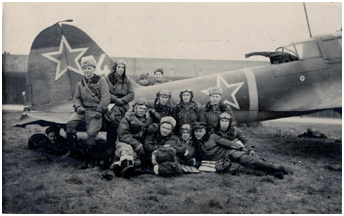 While the Il-2 was built in several versions, the most produced was officially designated Il-2-AM-38F (Il-2 Type 3 or Il-2M3 in Western literature). However, this designation could hide several variations.
The standard armament consisted of two 20 mm ShVAK or two 23 mm VYa cannons and two 7.62 mm ShKAS machine guns mounted in the wings, up to 600 kg of bombs (of which 300 kg in the bomb bays under the wings or containers
with PTAB anti-tank bombs or AZh-2 incendiary bulbs) but only 400 kg with four RS-82 or RS-132 rockets (or their anti-tank versions RBS-82 and -132). In addition, a 12.7 mm UBT machine gun provided defense from the rear post.
A small series of aircraft had also been adapted to carry under the wings two 37 mm NS-37 guns mounted in gondolas. In order to compensate for the increased weight, the 20 mm guns were removed, and the bomb load was reduced
to 200 kg, the carrying of rockets being prohibited.
The regiments based in Germany were armed with Il-2 Type 3 and also had in their ranks a few dual-control aircraft designated Il-2U or sometimes UIl-2 when the modification of the aircraft had been carried out at unit level.
The reconnaissance and spotting units which arrived in Germany in 1945 (93. and 98.OKRAP) used Il-2KR which are discussed in the second part of the article entitled "Flight Logs"
(> Link).
While the Il-2 was built in several versions, the most produced was officially designated Il-2-AM-38F (Il-2 Type 3 or Il-2M3 in Western literature). However, this designation could hide several variations.
The standard armament consisted of two 20 mm ShVAK or two 23 mm VYa cannons and two 7.62 mm ShKAS machine guns mounted in the wings, up to 600 kg of bombs (of which 300 kg in the bomb bays under the wings or containers
with PTAB anti-tank bombs or AZh-2 incendiary bulbs) but only 400 kg with four RS-82 or RS-132 rockets (or their anti-tank versions RBS-82 and -132). In addition, a 12.7 mm UBT machine gun provided defense from the rear post.
A small series of aircraft had also been adapted to carry under the wings two 37 mm NS-37 guns mounted in gondolas. In order to compensate for the increased weight, the 20 mm guns were removed, and the bomb load was reduced
to 200 kg, the carrying of rockets being prohibited.
The regiments based in Germany were armed with Il-2 Type 3 and also had in their ranks a few dual-control aircraft designated Il-2U or sometimes UIl-2 when the modification of the aircraft had been carried out at unit level.
The reconnaissance and spotting units which arrived in Germany in 1945 (93. and 98.OKRAP) used Il-2KR which are discussed in the second part of the article entitled "Flight Logs"
(> Link).
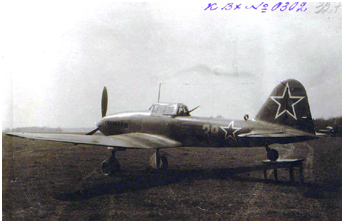
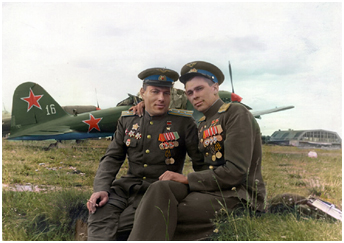 The designated successor of the Il-2 was the Il-10 which, although having an undeniable resemblance to the Il-2, was a very different aircraft, alleviating the shortcomings of its predecessor. The armored bathtub
protecting the engine and the pilot this time included the gunner's post. On the other hand, the armor of the upper part of the engine having proved useless in operations, this one was abandoned, which gave the
fuselage a more aerodynamic profile. The full metal-built Il-10 was a bit smaller than the Il-2 but had a Mikulin AM-42 engine providing 2000 hp at take-off against 1750 hp for the AM-38F of the Il-2. The "Beast"
as the Westerners have called it for once was aptly named. It was more maneuverable than the Il-2, was able to engage in combat against opposing fighters (it had held its own in simulated dogfights against a La-5FN
(2)), flew much faster (507 km/h at sea level against 375 km/h), higher (7480 m against 6000 m) and went further (800 km against 685 km). Whereas the fixed armament
remained identical with two VYa cannons and two ChKAS machine guns, the two small bomb bays located on either side of the main landing gear had been replaced by a larger bomb bay, the total bomb load remaining at 600 kg
and 400 kg with a total of four RS-82 or M-13 rockets. The rails of the latter were sometimes replaced by four bomb launchers for small caliber projectiles. An AFA-IM camera could fit under the rear fuselage. The prototype's
first flight took place on April 18 or 20, 1944, while the official decision to start production of the Il-10 was taken in August. The manufacture of the new aircraft was initially entrusted to Plants No.1 and No.18 in Kuybyshev.
The designated successor of the Il-2 was the Il-10 which, although having an undeniable resemblance to the Il-2, was a very different aircraft, alleviating the shortcomings of its predecessor. The armored bathtub
protecting the engine and the pilot this time included the gunner's post. On the other hand, the armor of the upper part of the engine having proved useless in operations, this one was abandoned, which gave the
fuselage a more aerodynamic profile. The full metal-built Il-10 was a bit smaller than the Il-2 but had a Mikulin AM-42 engine providing 2000 hp at take-off against 1750 hp for the AM-38F of the Il-2. The "Beast"
as the Westerners have called it for once was aptly named. It was more maneuverable than the Il-2, was able to engage in combat against opposing fighters (it had held its own in simulated dogfights against a La-5FN
(2)), flew much faster (507 km/h at sea level against 375 km/h), higher (7480 m against 6000 m) and went further (800 km against 685 km). Whereas the fixed armament
remained identical with two VYa cannons and two ChKAS machine guns, the two small bomb bays located on either side of the main landing gear had been replaced by a larger bomb bay, the total bomb load remaining at 600 kg
and 400 kg with a total of four RS-82 or M-13 rockets. The rails of the latter were sometimes replaced by four bomb launchers for small caliber projectiles. An AFA-IM camera could fit under the rear fuselage. The prototype's
first flight took place on April 18 or 20, 1944, while the official decision to start production of the Il-10 was taken in August. The manufacture of the new aircraft was initially entrusted to Plants No.1 and No.18 in Kuybyshev.
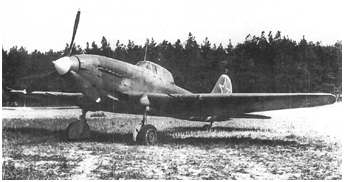
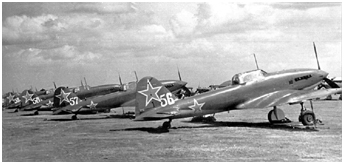 The first two Il-2 regiments to convert to the Il-10 were the 78.GvShAP of the 16.VA and the 108.GvShAP of 6.GvShAD subordinate to the 2.VA. Both (and then the other units concerned) joined Plant No.18 at the end of 1944
so that the personnel could undergo theoretical training. The latter then moved to Mukhanovo airfield where the 5th Reserve Aviation Regiment (ZAP - Zapasnoy Aviatsionnyy Polk) subordinated to the 1st Reserve
Aviation Brigade was based. This type of unit took charge of the new planes and ensured training of the crews on them. The operational beginnings of 108.GvShAP are known
(> Link).
On March 27, 1945, the first 25 Il-10 of the regiment joined the Sprottau Airfield in Silesia (nowadays Szprotawa), followed in the
following days by 10 additional aircraft, thus bringing the strength to 35 "shturmovik." Then began a period of preparation for combat of the men and the aircraft with technical interventions - related in particular to the
fairings of the landing gear and the doors of the bomb bays - in collaboration with "brigades" coming from Plants No.18 and No.24 (AM-42 engines). Training flights including the execution of missions to a firing range took
place from March 30 to April 14, representing 150 flights in 74 hours and 24 minutes. On April 14, 27 planes moved to Külpenau (Kiełpin now), joined by 7 other aircraft on the 16th - 1 aircraft was unavailable
following a forced landing on the 8th due to engine trouble after the failure of the crankshaft bearings after 29 hours of operation. The first fights took place from April 16 to 22 in the company of the 109. - seemingly
partly equipped with Il-10 - and the 110.GvShAP of the 6.GvShAD within the framework of the operations aiming at the capture of Berlin. Only 13 Il-10 were still in flying condition on April 27 after 208 combat sorties in
230 hours and 15 minutes of flight, or an average of 6.45 hours per aircraft. However, the main cause of this attrition was not due to losses in combat, but instead was due to the deterioration of nine engines with failed
piston rings. Three AM-42 engines and 28 sets of segments delivered by Plant No.24 made it possible to recondition several machines. The last sortie of the regiment took place on May 8 towards Prague, from the airfield at
Kohlo in Ost-Brandenburg (currently Koło) further west.
The first two Il-2 regiments to convert to the Il-10 were the 78.GvShAP of the 16.VA and the 108.GvShAP of 6.GvShAD subordinate to the 2.VA. Both (and then the other units concerned) joined Plant No.18 at the end of 1944
so that the personnel could undergo theoretical training. The latter then moved to Mukhanovo airfield where the 5th Reserve Aviation Regiment (ZAP - Zapasnoy Aviatsionnyy Polk) subordinated to the 1st Reserve
Aviation Brigade was based. This type of unit took charge of the new planes and ensured training of the crews on them. The operational beginnings of 108.GvShAP are known
(> Link).
On March 27, 1945, the first 25 Il-10 of the regiment joined the Sprottau Airfield in Silesia (nowadays Szprotawa), followed in the
following days by 10 additional aircraft, thus bringing the strength to 35 "shturmovik." Then began a period of preparation for combat of the men and the aircraft with technical interventions - related in particular to the
fairings of the landing gear and the doors of the bomb bays - in collaboration with "brigades" coming from Plants No.18 and No.24 (AM-42 engines). Training flights including the execution of missions to a firing range took
place from March 30 to April 14, representing 150 flights in 74 hours and 24 minutes. On April 14, 27 planes moved to Külpenau (Kiełpin now), joined by 7 other aircraft on the 16th - 1 aircraft was unavailable
following a forced landing on the 8th due to engine trouble after the failure of the crankshaft bearings after 29 hours of operation. The first fights took place from April 16 to 22 in the company of the 109. - seemingly
partly equipped with Il-10 - and the 110.GvShAP of the 6.GvShAD within the framework of the operations aiming at the capture of Berlin. Only 13 Il-10 were still in flying condition on April 27 after 208 combat sorties in
230 hours and 15 minutes of flight, or an average of 6.45 hours per aircraft. However, the main cause of this attrition was not due to losses in combat, but instead was due to the deterioration of nine engines with failed
piston rings. Three AM-42 engines and 28 sets of segments delivered by Plant No.24 made it possible to recondition several machines. The last sortie of the regiment took place on May 8 towards Prague, from the airfield at
Kohlo in Ost-Brandenburg (currently Koło) further west.
| ORBAT 1946 - 1949 |
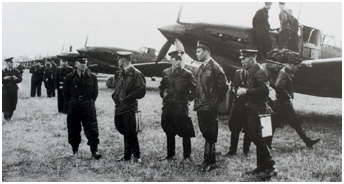
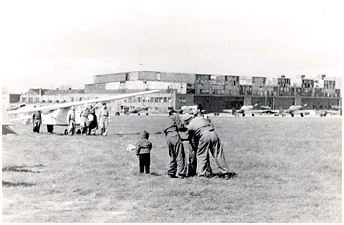 After the war, the Il-10 were also used to tow targets for the benefit of their own unit as mentioned, for example, in a CIA report from December 1951 about the Altes Lager airfield where two Il-10 regiments were stationed
at the time (> Link). A cable reel was mounted for this purpose under the aft fuselage. Like the Il-2, a training version designated UIl-10
or Il-10U was also in service.
After the war, the Il-10 were also used to tow targets for the benefit of their own unit as mentioned, for example, in a CIA report from December 1951 about the Altes Lager airfield where two Il-10 regiments were stationed
at the time (> Link). A cable reel was mounted for this purpose under the aft fuselage. Like the Il-2, a training version designated UIl-10
or Il-10U was also in service.
The Il-10 pilots practiced tactics reminiscent of those used by the Il-2 during the war. They were observed during training flights or during maneuvers in groups of four aircraft, in formations comprising an entire squadron,
or even a complete regiment. In this case, the unit was divided into squadrons 400 meters apart from each other, the latter flying in line abreast (diagram showing three groups of Il-2 of the 33.GvShAP on February 19, 1945
> Link - page 37 / attack on Finow Airfield by airplanes of the 9.ShAK on February 28, 1945
> Link - page 67). Low altitude attacks were carried out on targets located at the airfields of the regiments themselves. During the 1950s, practically every unit had an area on its airfield where a few targets were placed,
often representing the silhouettes of aircraft traced on the ground. A report from the West German Federal Intelligence Service (Bundernachrichtendienst - BND) from June 1956 gives us some details about the firing
range adjacent to the Brandenburg-Neuendorf airfield: "...The firing range located in the northwest corner of the land - approximately 100m x 150m - was provided with small houses, villages, woodlands and paths - at a scale of
approximately 1: 100 - for exercise." The planes (up to nine) flew in a circle formation at an altitude of 1,500 - 2,000 meters and each aircraft took turns in a dive attack at an angle of 30 to 45° pulling out at 200 - 150
meters (diagram of an attack on Mroczków by 10 Il-2 of the 33.GvShAP on January 16, 1945
> Link). The bombardments on the Wittstock and Kummersdorf firing ranges were carried out in formations of 3 to 12 planes, sometimes applying a tactic dating from the war that consisted of a first pass to drop the bombs,
a second dive pass to fire the rockets and, finally, a third pass also in a dive to fire the cannons and machine guns.
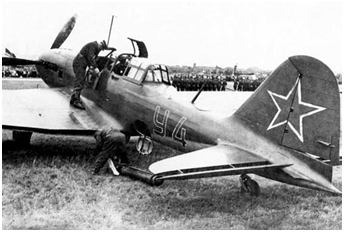
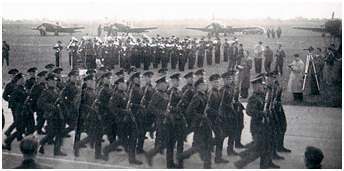 On April 14, 1951, the 200.GvShAD was struck by a tragedy, when 13 aircrews lost their lives in the bad weather around Kemlitz. According to a book entitled Nebesnyy Strazh GSVG by Ye. P. Tolmachev, the pilots were
not really qualified for instrument flight. Little is known about the profile of the mission. It is possible that aircraft from several regiments were involved. On the other hand, it is certain that the drama affected the
664.GvShAP. The grandson of the regimental commander was able to obtain an official archive document related to his grandfather's crash. It is stipulated that the latter hit the ground in the middle of a turn. So it would seem that some pilots were victims of spatial disorientation.
On April 14, 1951, the 200.GvShAD was struck by a tragedy, when 13 aircrews lost their lives in the bad weather around Kemlitz. According to a book entitled Nebesnyy Strazh GSVG by Ye. P. Tolmachev, the pilots were
not really qualified for instrument flight. Little is known about the profile of the mission. It is possible that aircraft from several regiments were involved. On the other hand, it is certain that the drama affected the
664.GvShAP. The grandson of the regimental commander was able to obtain an official archive document related to his grandfather's crash. It is stipulated that the latter hit the ground in the middle of a turn. So it would seem that some pilots were victims of spatial disorientation.
Production of the Il-10 ceased in 1948 after 4,540 (4,820?) aircraft had rolled out of Plants No.1 and No.18 in Kuybyshev and No.64 in Voronezh. However, a new version designated Il-10M differentiating essentially by a new
wing design with a larger span was manufactured by Plant n°168 of Rostov-on-Don between 1952 and 1954. The small number of aircraft built (136 or 146?) as well as the lack of iconographic sources makes it impossible to affirm
that this variant was in service within the 24.VA in the GDR (3).
The first attempt by the Ilyushin OKB to create a successor to the Il-10 failed in 1948 with the Il-20 (> Link). However, the design bureau did not give up and began
at the beginning of the fifties to work on another "shturmovik" designated Il-40 (> Link) of which the prototype powered by two Tumanskiy RD-9V reactors took off on
March 7, 1953.
| ORBAT 1949 - 1956 |
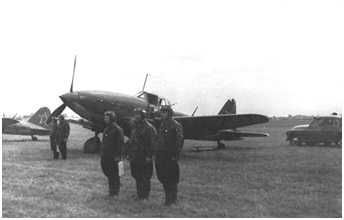
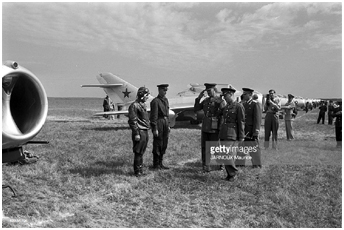 However, the VVS did not wait for the possible production of this new aircraft to start the conversion of some Il-10 units to the MiG-15. The most-produced version of the MiG-15, made famous by its participation in the
Korean War, was the MiG-15bis "Fagot-B" of which 8000 aircraft were built out of a total of 13,131 not counting those built by license. The onboard armament composed of a 37mm Nudel'man N-37 gun mounted to the right of
the nose and two 23mm Nudel'man-Rikhter NR-23 guns on the left side no doubt made that fighter disguised as a "shturmovik" an aircraft capable of doing damage during strafing passes on the ground. A 2,700 kgp Klimov VK-1
reactor replaced the 2,270 kgp RD-45F of the MiG-15, ensuring a speed of 1079 km/h at sea level but slightly reducing the range that decreased from around 1300 km to 1200 km at 10,000 meters above sea level. There were
only two hard points under the wings. The weapons were attached to them directly without the intermediary of a supporting pylon because the bomb launchers were mounted inside the wings. The weapons load was limited to
two 250 kg bombs. Initially the external fuel tanks available in different capacities of 260, 300 or 400 liters were mounted flush with the lower surface of the wings, but cylindrical 400-liter drop tanks could normally be
attached via a central pylon with two smaller ones attached to either side of the tanks to stabilize them. A variant of the MiG-15bis dedicated to ground attack had two additional hard points located between the landing gear
and the original hard points, to which a weapon pylon could be mounted. However, the prototype of this version (a modified MiG-15bis) was not built until early 1958. Consequently, for the question of timing explained further below,
this MiG-15 modification could not equip the regiments of "shturmovik" based in the GDR.
Some Il-10 regiments of the 24.VA were therefore gradually converted on the MiG-15 or probably the MiG-15bis beginning in 1954. A CIA report dated from January 1955
(> Link) provided some details on the conversion process. MiG-15 and UTI MiG-15 two-seater flights were first observed at Finsterwalde
on April 27, 1954 and at Alt Lönnewitz (Falkenberg) in early June (4). These initial training flights lasted only four to five minutes, sometimes with the
landing gear down.
However, the VVS did not wait for the possible production of this new aircraft to start the conversion of some Il-10 units to the MiG-15. The most-produced version of the MiG-15, made famous by its participation in the
Korean War, was the MiG-15bis "Fagot-B" of which 8000 aircraft were built out of a total of 13,131 not counting those built by license. The onboard armament composed of a 37mm Nudel'man N-37 gun mounted to the right of
the nose and two 23mm Nudel'man-Rikhter NR-23 guns on the left side no doubt made that fighter disguised as a "shturmovik" an aircraft capable of doing damage during strafing passes on the ground. A 2,700 kgp Klimov VK-1
reactor replaced the 2,270 kgp RD-45F of the MiG-15, ensuring a speed of 1079 km/h at sea level but slightly reducing the range that decreased from around 1300 km to 1200 km at 10,000 meters above sea level. There were
only two hard points under the wings. The weapons were attached to them directly without the intermediary of a supporting pylon because the bomb launchers were mounted inside the wings. The weapons load was limited to
two 250 kg bombs. Initially the external fuel tanks available in different capacities of 260, 300 or 400 liters were mounted flush with the lower surface of the wings, but cylindrical 400-liter drop tanks could normally be
attached via a central pylon with two smaller ones attached to either side of the tanks to stabilize them. A variant of the MiG-15bis dedicated to ground attack had two additional hard points located between the landing gear
and the original hard points, to which a weapon pylon could be mounted. However, the prototype of this version (a modified MiG-15bis) was not built until early 1958. Consequently, for the question of timing explained further below,
this MiG-15 modification could not equip the regiments of "shturmovik" based in the GDR.
Some Il-10 regiments of the 24.VA were therefore gradually converted on the MiG-15 or probably the MiG-15bis beginning in 1954. A CIA report dated from January 1955
(> Link) provided some details on the conversion process. MiG-15 and UTI MiG-15 two-seater flights were first observed at Finsterwalde
on April 27, 1954 and at Alt Lönnewitz (Falkenberg) in early June (4). These initial training flights lasted only four to five minutes, sometimes with the
landing gear down.
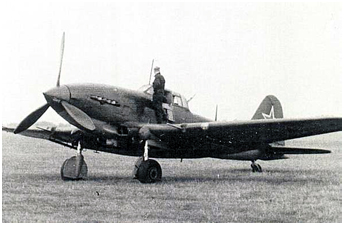
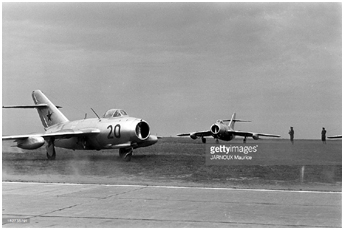 A dozen aircraft seen at Finsterwalde were identified as coming from different fighter units, perhaps transferred temporarily to ensure the transition of the Il-10 pilots. However, another report from April 1956, spreads doubt as
to whether the units flying the MiG-15bis finally received new aircraft or if they only flew aircraft formerly on strength with fighter regiments of the 24.VA. The latter had started their conversion to the MiG-17 in early
1955: the CIA specifies that the first 20 boxes containing the new planes arrived at Altes Lager on March 8. Combat training was done alone or in formations of up to nine aircraft. The ranges used included the one at the
old Gahro airfield near Debern north of Finsterwalde. They practiced mock dive attacks at an angle of 40 to 60° and firing passes with short bursts. The MiG-15s, just like the Il-10s, also were seen dropping bombs in horizontal
flight. Western observers believed that the order to drop the bombs was transmitted by radio, the position of the planes being estimated with a ground radar. In fact, the Il-10 had a VMSh-10 delay mechanism (VMSh-2 on the Il-2
- Vremenny Mekhanism Shturmovika or ground-attack aircraft timing mechanism) which automatically released the bombs after a specified period of time after the nose of the aircraft hid the target.
On December 22, 1954, Marshal Aleksandr M. Vasilevskiy, Deputy Minister of Defense and Marshal of Aviation Pavel F. Zhigarev, Commander of the VVS and Deputy Minister of Defense addressed a note to the Council of Ministers
specifying that the average Ground-Attack Aviation fleet in 1955 would include 1340 Il-10 and 224 UIl-10 having exhausted their lifespan.
Of the six "shturmovik" regiments present in the GDR in 1956, the three units of the 114.GvShAD and probably the 710.GvShAP of the 200.GvShAD had MiG-15bis in their ranks.
The transfer of the 710.GvShAP from Stendal to Falkenberg in March 1956 indeed suggests that the unit made its conversion to the MiG-15bis there. The 664.GvShAP of the 114.GvShAP flying on MiG-15bis was based there at that time.
The photos that illustrate this article seem to indicate that while they were indeed MiG-15bis, these were from the first production batches, if we judge by the shape of their external drop tanks and the presence of the landing
and taxiing light housed in the air inlet of the engine that later was moved under the left wing.
While the "Fagot" played "shturmovik," the Il-40 prototype encountered development problems. Its reactors mounted on either side of the fuselage could not continue to function when they ingested the gases from even just one
of its six 23mm NR-23 cannons. A new prototype designated Il-40P with extended air intakes at the very front of the nose and a new armament consisting of only four AM-23 guns but with a higher rate of fire, left the ground for
the first time on the February 14, 1955.
On April 10, 1956, Marshal of Aviation Pavel F. Zhigarev and Marshal of Aviation Sergey I. Rudenko, former Commander of the 16.VA who at the time had become Chief of the General Staff and First Deputy Commander-in-Chief of
the VVS, sent Minister of Defense Marshal of the Soviet Union Zhukov the following note: "1. In view of the fact that the Il-10 planes are worn out and that the flights on board are dangerous, you have made the decision in
January 1956 to re-equip all ground-attack units with MiG-15bis in 1956 [therefore those not yet re-equipped on that date] and, to this end, according to the plan you approved on January 20, 1956, 581 MiG-15bis aircraft were
planned..." The note proposed to transform 10 ground-attack divisions into fighter-bomber units (the 114.GvShAP was on the list). They had to train to use their MiG-15bis like fighter-bombers while awaiting the availability of a light
bomber (Il-40P?). The other divisions still flying the MiG-15bis were to follow the fighter training program.
A dozen aircraft seen at Finsterwalde were identified as coming from different fighter units, perhaps transferred temporarily to ensure the transition of the Il-10 pilots. However, another report from April 1956, spreads doubt as
to whether the units flying the MiG-15bis finally received new aircraft or if they only flew aircraft formerly on strength with fighter regiments of the 24.VA. The latter had started their conversion to the MiG-17 in early
1955: the CIA specifies that the first 20 boxes containing the new planes arrived at Altes Lager on March 8. Combat training was done alone or in formations of up to nine aircraft. The ranges used included the one at the
old Gahro airfield near Debern north of Finsterwalde. They practiced mock dive attacks at an angle of 40 to 60° and firing passes with short bursts. The MiG-15s, just like the Il-10s, also were seen dropping bombs in horizontal
flight. Western observers believed that the order to drop the bombs was transmitted by radio, the position of the planes being estimated with a ground radar. In fact, the Il-10 had a VMSh-10 delay mechanism (VMSh-2 on the Il-2
- Vremenny Mekhanism Shturmovika or ground-attack aircraft timing mechanism) which automatically released the bombs after a specified period of time after the nose of the aircraft hid the target.
On December 22, 1954, Marshal Aleksandr M. Vasilevskiy, Deputy Minister of Defense and Marshal of Aviation Pavel F. Zhigarev, Commander of the VVS and Deputy Minister of Defense addressed a note to the Council of Ministers
specifying that the average Ground-Attack Aviation fleet in 1955 would include 1340 Il-10 and 224 UIl-10 having exhausted their lifespan.
Of the six "shturmovik" regiments present in the GDR in 1956, the three units of the 114.GvShAD and probably the 710.GvShAP of the 200.GvShAD had MiG-15bis in their ranks.
The transfer of the 710.GvShAP from Stendal to Falkenberg in March 1956 indeed suggests that the unit made its conversion to the MiG-15bis there. The 664.GvShAP of the 114.GvShAP flying on MiG-15bis was based there at that time.
The photos that illustrate this article seem to indicate that while they were indeed MiG-15bis, these were from the first production batches, if we judge by the shape of their external drop tanks and the presence of the landing
and taxiing light housed in the air inlet of the engine that later was moved under the left wing.
While the "Fagot" played "shturmovik," the Il-40 prototype encountered development problems. Its reactors mounted on either side of the fuselage could not continue to function when they ingested the gases from even just one
of its six 23mm NR-23 cannons. A new prototype designated Il-40P with extended air intakes at the very front of the nose and a new armament consisting of only four AM-23 guns but with a higher rate of fire, left the ground for
the first time on the February 14, 1955.
On April 10, 1956, Marshal of Aviation Pavel F. Zhigarev and Marshal of Aviation Sergey I. Rudenko, former Commander of the 16.VA who at the time had become Chief of the General Staff and First Deputy Commander-in-Chief of
the VVS, sent Minister of Defense Marshal of the Soviet Union Zhukov the following note: "1. In view of the fact that the Il-10 planes are worn out and that the flights on board are dangerous, you have made the decision in
January 1956 to re-equip all ground-attack units with MiG-15bis in 1956 [therefore those not yet re-equipped on that date] and, to this end, according to the plan you approved on January 20, 1956, 581 MiG-15bis aircraft were
planned..." The note proposed to transform 10 ground-attack divisions into fighter-bomber units (the 114.GvShAP was on the list). They had to train to use their MiG-15bis like fighter-bombers while awaiting the availability of a light
bomber (Il-40P?). The other divisions still flying the MiG-15bis were to follow the fighter training program.
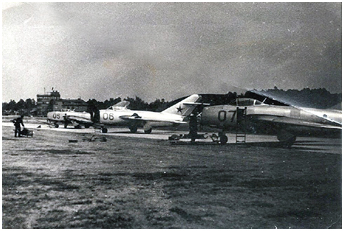
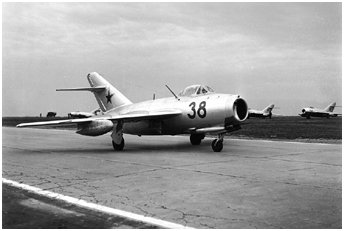 But the future of the "shturmovik" was about to change. As of April 13, the Il-40P program was stopped when five aircraft of the first production batch of forty aircraft had been completed. On April 29, Ministry of Defense
Directive n°30660 decreed the dismantling of ground-attack aviation! One can imagine, however, that the decision came from above, namely from Nikita Khrushchev, First Secretary of the Central Committee of the Communist Party
of the Soviet Union. The latter was probably betting at the time on the advent of missiles, initially those of medium range. A directive from VVS Headquarters dated May 11,1956 confirmed this decision. The 19 "shturmovik"
divisions that comprised the VVS were to be disbanded or transformed. Ten of them became fighter-bomber regiments (IBAP). The other nine divisions were disbanded, and their planes and personnel distributed among the fighter
divisions of Front Aviation and Air Defense Forces (PVO). The Il-10s considered obsolete were withdrawn from service.
The logical consequence of these decisions was the withdrawal of the "shturmovik" regiments based in the GDR. On May 14, 1956, the Soviets announced that by May 1, 1957, 1.2 million men would be demobilized, including 33,000
from the GSFG, while the armed forces had already been reduced by 640,000 in 1955. The departure of three divisions of the 24.VA would follow in the wake of this announcement. These were the two ground-attack aviation divisions
of the 24.VA, the 114. and 200.GvShAD as well as the 221st Bombing Division (BAD) of which at least 70 Il-28 left Oranienburg on August 26 - according to a BND report about the departure in June and July 1953 of six
bomber regiments equipped with Il-28s, these units had about 20 aircraft on strength. To this, we must also add the
fighters of the 123.IAD and the Il-28R of a reconnaissance regiment (98.OGRAP?) based at Oranienburg in October and perhaps another BAD (the 166th?). On May 17, the 200.GvShAD started to withdraw its aircraft when the MiG-15bis
of the 710.GvShAP left Alt Lönnewitz. On June 20, the Il-10s of 635. and 830.GvShAP departed their airfield in Brandenburg-Neuendorf,
the former location of the Arado Flugzeugwerke factories. Finally, on August 27, it was the turn of the three regiments of the 114.GvShAD, namely the 664., 725., and 823.GvShAP, to leave Finsterwalde with their
MiG-15bis. Most of these departures - Oranienburg, Neuendorf, and Finsterwalde are documented - were the subject of a major propaganda operation, the local and international press being invited as well as the authorities,
civil organizations, and even the three Western military liaison missions. The intelligence services of the West were therefore able to work with ease and the BND detailed through the menu certain departures, the essentials
of which follow.
But the future of the "shturmovik" was about to change. As of April 13, the Il-40P program was stopped when five aircraft of the first production batch of forty aircraft had been completed. On April 29, Ministry of Defense
Directive n°30660 decreed the dismantling of ground-attack aviation! One can imagine, however, that the decision came from above, namely from Nikita Khrushchev, First Secretary of the Central Committee of the Communist Party
of the Soviet Union. The latter was probably betting at the time on the advent of missiles, initially those of medium range. A directive from VVS Headquarters dated May 11,1956 confirmed this decision. The 19 "shturmovik"
divisions that comprised the VVS were to be disbanded or transformed. Ten of them became fighter-bomber regiments (IBAP). The other nine divisions were disbanded, and their planes and personnel distributed among the fighter
divisions of Front Aviation and Air Defense Forces (PVO). The Il-10s considered obsolete were withdrawn from service.
The logical consequence of these decisions was the withdrawal of the "shturmovik" regiments based in the GDR. On May 14, 1956, the Soviets announced that by May 1, 1957, 1.2 million men would be demobilized, including 33,000
from the GSFG, while the armed forces had already been reduced by 640,000 in 1955. The departure of three divisions of the 24.VA would follow in the wake of this announcement. These were the two ground-attack aviation divisions
of the 24.VA, the 114. and 200.GvShAD as well as the 221st Bombing Division (BAD) of which at least 70 Il-28 left Oranienburg on August 26 - according to a BND report about the departure in June and July 1953 of six
bomber regiments equipped with Il-28s, these units had about 20 aircraft on strength. To this, we must also add the
fighters of the 123.IAD and the Il-28R of a reconnaissance regiment (98.OGRAP?) based at Oranienburg in October and perhaps another BAD (the 166th?). On May 17, the 200.GvShAD started to withdraw its aircraft when the MiG-15bis
of the 710.GvShAP left Alt Lönnewitz. On June 20, the Il-10s of 635. and 830.GvShAP departed their airfield in Brandenburg-Neuendorf,
the former location of the Arado Flugzeugwerke factories. Finally, on August 27, it was the turn of the three regiments of the 114.GvShAD, namely the 664., 725., and 823.GvShAP, to leave Finsterwalde with their
MiG-15bis. Most of these departures - Oranienburg, Neuendorf, and Finsterwalde are documented - were the subject of a major propaganda operation, the local and international press being invited as well as the authorities,
civil organizations, and even the three Western military liaison missions. The intelligence services of the West were therefore able to work with ease and the BND detailed through the menu certain departures, the essentials
of which follow.
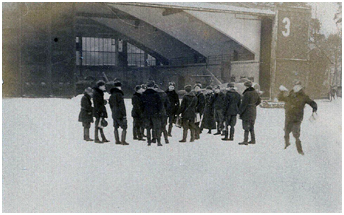
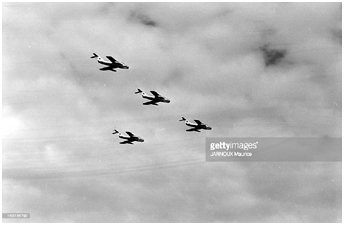 Thus, a rehearsal of the troops farewell parade was observed on June 19 in Neuendorf (designated Brandenburg-Industriehafen). The next day, the parade, supported by a military band, began at 12 noon. Marshal of the Soviet
Union Andrey A. Grechko, Commander-in-Chief of the GSFG, was among the distinguished guests. Sixteen fighters equipped with drop tanks, divided into four groups, then flew over the airfield at an altitude of 500 meters.
According to the commentator, these were the first 200.GvShAD aircraft that left for the USSR (the only MiG-15s of the 200.GvShAD had left Falkenberg on May 17 !?). These formations were immediately followed by the rapid
passage of another aircraft with a flame two meters long coming out of its tailpipe (therefore a MiG-17 coming from a fighter unit, like undoubtedly the 16 previous fighters). Then, three Type 32 (5)
helicopters (Mi-1s) bearing red side numbers 26/27/28 flew in front of the stands at low altitude. An officer descended from one of them via a rope ladder and presented himself in front of the Glavkom (6)
before re-boarding. Also, a dozen Type 36 helicopters (Mi-4s) with red side numbers landed and later departed. At 2 p.m., a white rocket was fired and the Il-10s started their engines. The first of 75 planes (89 according to
the news) took off in gloomy weather after 5 minutes, departing in groups of 10. The planes' side numbers were painted light blue, red with white edges, a few reds, and two yellows. Further on, the report also speaks of white
and green side numbers... The rear-gunner's position was occupied and devices suspected of being weapon pylons were attached under the wings and the belly (the Il-10 had no ventral loading point; the observers simply saw the
air intake of the the carburettor, and its ventral air filter fairing under the fuselage > Photo). No technical problem was noticed.
Thus, a rehearsal of the troops farewell parade was observed on June 19 in Neuendorf (designated Brandenburg-Industriehafen). The next day, the parade, supported by a military band, began at 12 noon. Marshal of the Soviet
Union Andrey A. Grechko, Commander-in-Chief of the GSFG, was among the distinguished guests. Sixteen fighters equipped with drop tanks, divided into four groups, then flew over the airfield at an altitude of 500 meters.
According to the commentator, these were the first 200.GvShAD aircraft that left for the USSR (the only MiG-15s of the 200.GvShAD had left Falkenberg on May 17 !?). These formations were immediately followed by the rapid
passage of another aircraft with a flame two meters long coming out of its tailpipe (therefore a MiG-17 coming from a fighter unit, like undoubtedly the 16 previous fighters). Then, three Type 32 (5)
helicopters (Mi-1s) bearing red side numbers 26/27/28 flew in front of the stands at low altitude. An officer descended from one of them via a rope ladder and presented himself in front of the Glavkom (6)
before re-boarding. Also, a dozen Type 36 helicopters (Mi-4s) with red side numbers landed and later departed. At 2 p.m., a white rocket was fired and the Il-10s started their engines. The first of 75 planes (89 according to
the news) took off in gloomy weather after 5 minutes, departing in groups of 10. The planes' side numbers were painted light blue, red with white edges, a few reds, and two yellows. Further on, the report also speaks of white
and green side numbers... The rear-gunner's position was occupied and devices suspected of being weapon pylons were attached under the wings and the belly (the Il-10 had no ventral loading point; the observers simply saw the
air intake of the the carburettor, and its ventral air filter fairing under the fuselage > Photo). No technical problem was noticed.
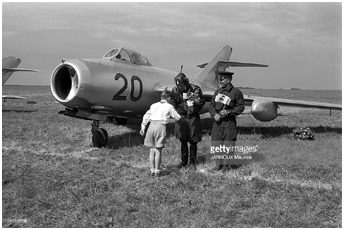
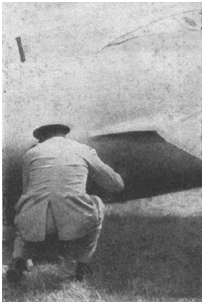 Un officier de la USMLM tente d'arracher tous les secrets d'un UTI MiG-15 à Finsterwalde... ©Flügel der Heimat.
Un officier de la USMLM tente d'arracher tous les secrets d'un UTI MiG-15 à Finsterwalde... ©Flügel der Heimat.
A USMLM officer tries to extract all the secrets from a UTI MiG-15 at Finsterwalde... ©Flügel der Heimat.
The departure from Finsterwalde on Wednesday August 27 was classic: a parade and speeches preceded the take-offs. The Soviet national anthem was played with accompanying fourteen salvos fired by a DCA battery. No less than
96 MiG-15 and UTI MiG-15 flew east. The aircraft taxied in groups of 5 on the runway, regrouping in formations of 10 aircraft in flight. Finally, 69 MiGs flew over the base in farewell. The aircraft were fitted with their
drop tanks and were color-coded red, blue, and yellow. Four Li-2s were present on the airbase.
In 1957, the fighter-bomber regiments were created, but it was not until 1960 that the 24.VA included them in its strength. However, strictly speaking, these were not new units... Instead, they were former fighter regiments
with a new mission and a new designation. However, the latter undoubtedly only underlined the primary mission of these "new" units because the fighters did not wait for this deadline to practise ground attack. Thus, a CIA
report from March 1954 (> Link) details how the new MiG-15 fighter pilots were training for bombardment in 1952 - 1953. Dives at an angle
of 50 to 60° were practiced from altitudes varying from 2000 to 5000 meters pulling out at 500 meters. The dropping of bombs was observed on the Kummersdorf firing range in 1953. Attacks on mock-up tanks were also noted.
As for the Il-40, it would see the light of day in a modernized form with the designation Il-102 (> Link). Experience had indeed shown that fighter-bombers could not
replace Ground-Attack Aviation. Il'yushin's new plane made its first flight on September 25, 1982, but it was ultimately the Sukhoy Su-25 that would equip the "shturmovik" squadrons resurrected in the mid-eighties as we will
see in the last part of this chapter.
notes
(1) VVS RKKA: Voyenno-Vozdushniye Sily Raboche-Krest'yanskoy Krasnoy Armii or Military Air Forces of the Workers
and Peasants Red Army as Soviet military aviation was called between 1924 and 1946.
(2)
Such a fight took place on March 28, 1945 over Sprottau Airfield between an Il-10 of the 108.GvShAP flown by Guards Captain A. I. Sirotkin and
a La-5FN flown by Guards Senior Lieutenant V. I. Popkov of the 5.GvIAP (> Link)
(3)
In fifty years of existence, the Air Army supporting the Soviet Air Forces stationed in Eastern Germany changed its tactical number twice.
The first time was in January 1949 when the 16.VA became the 24.VA and the second time was in April 1968 when it returned to its original
designation of 16.VA. However, in June 1980, the 16.VA temporarily lost that designation and became the "Military Air Forces of the Group of
Soviet Forces in Germany" until May 1988.
(4)
Until 1955, the bort numbers consisted of 3 to 4 digits chosen from the construction number, with each plant combining the digits in its own way.
Thus, a list of almost 33 pages drawn up by the Western intelligence services listing the codes of the MiG-15s observed in the GDR between
October 1952 and May 1955 begins with the number '001' noted at Altes Lager on March 14, 1955, goes through bort number 1129 observed at
Damgarten on October 16, 1952, and ends with the code '2495' seen at Neuruppin on April 5, 1954.
(5)
This was the type identification number in the nomenclature of the US Department of Defense (DOD).
(6)
Glavnokomanduyushchiy or Commander-in-Chief.
videos
> Neuendorf departure on June 20, 1956 - general view > Link.
> Neuendorf departure on June 20, 1956 - general view and Il-10 > Link (no sound).
 |
Plan du site - Sitemap |  |
